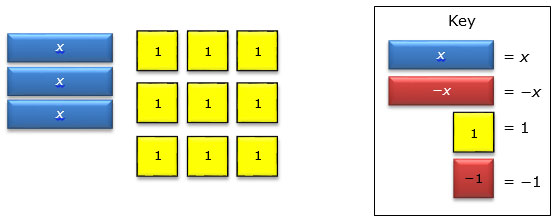In the previous sections, you used the commutative and associative properties of addition and multiplication to determine whether or not two expressions are equivalent. In this section, you will investigate an additional property that you can use to determine if two expressions are equivalent.
![]() Use the interactive below to determine whether or not the given expressions are equivalent. Record your results in a table like the one shown. Click the Next button to see the next pair of expressions.
Use the interactive below to determine whether or not the given expressions are equivalent. Record your results in a table like the one shown. Click the Next button to see the next pair of expressions.
Copy the following table into a word processing or spreadsheet app or program. Use the results from the interactive to complete the table.
Expression 1 |
Expression 2 |
Equivalent? (Yes/No) |
2(x + 3) |
2x + 6 |
|
3(1 + 2x) |
3 + 6x |
|
4(x + 1) |
4x + 1 |
|
3x − 6 |
3(x − 6) |
|
2x − 8 |
2(x − 4) |
Interactive popup. Assistance may be required.
Expression 1 |
Expression 2 |
Equivalent? (Yes/No) |
2(x + 3) |
2x + 6 |
Yes |
3(1 + 2x) |
3 + 6x |
Yes |
4(x + 1) |
4x + 1 |
No |
3x − 6 |
3(x − 6) |
No |
2x − 8 |
2(x − 4) |
Yes |

Use your completed table and the interactive to answer the questions that follow.
Interactive popup. Assistance may be required.
Yes, the two expressions are equivalent because the scale is balanced and the scale contains the same number of each block on both sides.
Interactive popup. Assistance may be required.
No, the two expressions are not equivalent because the scale is not balanced and the scale contains different numbers of each block on each side.
Interactive popup. Assistance may be required.
No. If you follow the order of operations in the first expression, you add 4 + 6 first to get 10, and then divide 24 by 10 to get 2.4. In the second expression, you perform the division inside parentheses first to get (6) + (4), and then simplify 6 + 4 = 10. Both expressions simplify to different numbers.
Interactive popup. Assistance may be required.
Yes. If you follow the order of operations in the first expression, you add 16 + 12 first to get 28, and then divide 28 by 4 to get 7. In the second expression, you perform the division inside parentheses first to get (4) + (3), and then simplify 4 + 3 = 7. Both expressions simplify to the same number.
The distributive property of equality states that the product of a quantity and a sum of two addends is equal to the sum of the product of the quantity and each addend. For which combinations of operations does the distributive property hold true?

Generalize the distributive property using the numbers a, b, and c.


Jeannie’s friend, Antonio, said that Jeannie modeled the expression 3(x + 3). Is Antonio correct? Explain.

Which students wrote equivalent expressions?

